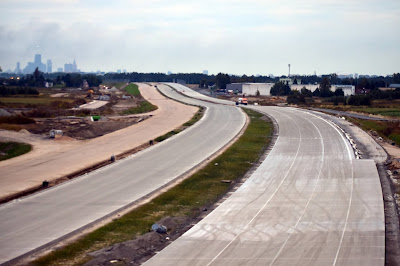Trains of thought - let them run, coupling from one to another - the default mode network at work in the brain. Sit back, detach yourself from what you're doing, and let your mind wander at will; mundane concerns - bills to pay, household tasks to complete, one thought leads to another - issues to resolve, emails to write - at the higher level, ideas half-digested,
Then along comes that flash of insight - a moment of sudden realisation of something new, a new correlation, some deep truth that had not been hitherto appreciated. Generated as the result of a lumbering train of thought, chugging ever onward, the synthesis of what you have been reading, listening to, thinking about - and then a higher understanding clicks.
But what of the truly unbidden thought - inspiration - the Holy Spirit, for those who choose to think in these terms. These are rarer. They feel like they are from an extraneous source. The notion of 'voices' has a negative connotation, aligned with mental illness, schizophrenia - auditory verbal hallucinations. But these inspirations are non-verbal - they are as silent, wordless, as the thoughts in a train of thought. I am experiencing what feels like an unbidden inbound thought; telepathy rather than a voice.
Should I trust their veracity? One I had this summer - I felt the need before turning in to go outside onto the rear balcony of the house on my działka and look at the night sky. As I did so, the thought came to my mind "everyone who seeks God must find their own way". Profound stuff. Feels so right!
Another one I had many years ago (and reported on this blog) is that "we are all part of a continuous whole". Yet another is the notion of congruence in memories. Thoughts, ideas, unbidden - as opposed to unbidden qualia memories (of subjective experiences).
'Unbidden' is the crucial word here. The insights fall into a train of thought that's under way; they are neither summoned nor do they result from the preceding thought.
Summoning - or channelling - is a separate matter. I had a go at channelling alien intelligences three months ago. Just as I was about to drop off, I channelled the aliens to ask how mankind can get nuclear fusion to work. [Atomic energy, but without uranium and other nastiness we get from fission reactors.]
The answer was instantaneous and astonishing: "Have a look at anomalous data from experiments conducted in March 1970". I wasn't expecting this!
Seven weeks later, my brother then pointed me to this:
Nuclear Fusion Reactions in Solid-Deuterium Laser-Produced Plasma
F. Floux, D. Cognard, L -G. Denoeud, G. Piar, D. Parisot, J. L. Bobin, F. Delobeau, and C. Fauquignon
Phys. Rev. A 1, 821 – Published 1 March 1970
He points out that the experiments mentioned in this paper must have been conducted before March 1970, a time in which research around the world had switched from various forms of fusion reactor (Astron, Levitron, Magnetic Mirror and Bumpy Torus) towards the one that the Soviets had demonstrated so much promise with - the Tokamak. Maybe scientists had rejected a promising technology because of anomalous data? Interesting... And in case you're wondering - the answer to my question did not come to me in either English or Polish, rather as a telepathic message.
Nie odpuszczaj sobie!
This time two years ago:
Parliamentary train at West Ealing station
This time three years ago:
Progress in Jakubowizna
This time five years ago:
Miedzianka by Filip Springer
This time six years ago:
Out of the third, into the fourth
This time seven years ago:
Inverted reflections
This time eight years ago:
Observations from London's WC1
and Observations from the City of London
This time seven years ago:
Civilising Jeziorki's wetlands
This time ten years ago:
Warsaw's Aleje Jerozolimskie
This time 12 years ago:
Melancholy autumn mood in Łazienki
This time 13 years ago:
Autumn gold, Zamienie
This time 14 years ago:
Flamenco Sketches - Seville














































